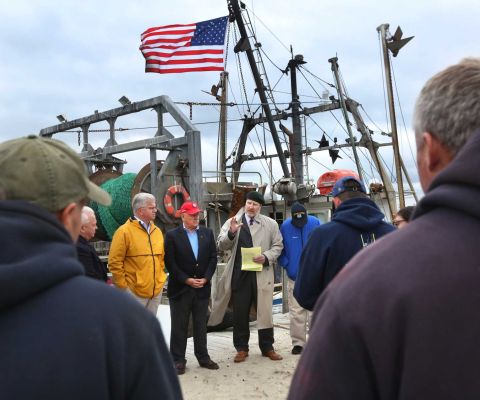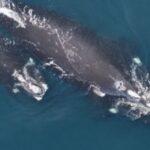Daily Archives: October 1, 2015
New York Commercial Fishermen blast new Department of Environmental Conservation report
 Commercial fishing advocates Thursday lambasted a new state report that criticizes New York’s top fisheries regulator. At a rally beside a commercial fishing trawler in Hampton Bays, two state lawmakers joined several dozen fishermen and fisherwomen and an attorney for fishermen in blasting the report as a “whitewash.” The report by the state inspector general, released on Wednesday, said the state Department of Environmental Conservation failed to process years of paperwork that fishermen are required to fill out every time they fish; DEC enforcement officers were improperly directing plea agreements, leading to possible “coercion” of defendants, and that property seized in arrests wasn’t returned after fishermen’s acquittals. Read the rest here 21:35:
Commercial fishing advocates Thursday lambasted a new state report that criticizes New York’s top fisheries regulator. At a rally beside a commercial fishing trawler in Hampton Bays, two state lawmakers joined several dozen fishermen and fisherwomen and an attorney for fishermen in blasting the report as a “whitewash.” The report by the state inspector general, released on Wednesday, said the state Department of Environmental Conservation failed to process years of paperwork that fishermen are required to fill out every time they fish; DEC enforcement officers were improperly directing plea agreements, leading to possible “coercion” of defendants, and that property seized in arrests wasn’t returned after fishermen’s acquittals. Read the rest here 21:35:
Fishermen are safe again in the Faroe Islands, while the Sea Shepherd Supports the Faroe Islands
 Landcrew ( over 100 volunteers) has paid over 600.000,00 danish kroners to get to Faroe Islands by plane – so faroese tourism is blooming once again – thanks to the Sea Shepherd. Records also show – that Sea Shepherd landcrew has used a lot of car rentals and houses and they have been in the Faroe haven’t been cheap, and we thank you for that, Sea Shepherd. And then Sea Shepherd also needs to pay up to Faroese government for all the big fines – they have been given for unlawfully interfering with the whaling. They didn’t save one single whale! Read the rest here 20:13
Landcrew ( over 100 volunteers) has paid over 600.000,00 danish kroners to get to Faroe Islands by plane – so faroese tourism is blooming once again – thanks to the Sea Shepherd. Records also show – that Sea Shepherd landcrew has used a lot of car rentals and houses and they have been in the Faroe haven’t been cheap, and we thank you for that, Sea Shepherd. And then Sea Shepherd also needs to pay up to Faroese government for all the big fines – they have been given for unlawfully interfering with the whaling. They didn’t save one single whale! Read the rest here 20:13
Measuring the Effects of New England Catch Shares – Indicator: Crew Employment and Compensation
 The total numbers of groundfish vessel crew positions and crew trips, by fishing year, for all home port states have decreased through the baseline period and into the initial years of the catch share program. The number of crew positions serves as an indicator of the available jobs, whereas the number of crew trips is the number of trips available for crew to work, or the total opportunities for crew to earn a share of the landings revenues. States with the highest involvement in the fishery (Massachusetts, Rhode Island, and Maine) experienced an overall decrease in crew trips and the number of crew positions per vessel remained relatively constant. Read the rest here San Francisco – Catch shares leave fishermen reeling Read the rest here 19:12
The total numbers of groundfish vessel crew positions and crew trips, by fishing year, for all home port states have decreased through the baseline period and into the initial years of the catch share program. The number of crew positions serves as an indicator of the available jobs, whereas the number of crew trips is the number of trips available for crew to work, or the total opportunities for crew to earn a share of the landings revenues. States with the highest involvement in the fishery (Massachusetts, Rhode Island, and Maine) experienced an overall decrease in crew trips and the number of crew positions per vessel remained relatively constant. Read the rest here San Francisco – Catch shares leave fishermen reeling Read the rest here 19:12
Many young fish moving north with adults as climate changes
 Researchers found that larval stages of 43 percent of the species studied changed distribution, while adult stages of 50 percent of the species shifted distribution over the same time period. Shifts were predominantly northwards or along the shelf for both life stages, which is expected given the warming ocean in the region. In addition to distribution changes, the study also found changes in spawning times and locations for some species, implying a link between changes in distribution and changes in the environment. Larvae of winter and spring species like yellowtail flounder generally shifted earlier in the season. Summer and fall species like monkfish shifted later in the season. Read the rest here 14:42
Researchers found that larval stages of 43 percent of the species studied changed distribution, while adult stages of 50 percent of the species shifted distribution over the same time period. Shifts were predominantly northwards or along the shelf for both life stages, which is expected given the warming ocean in the region. In addition to distribution changes, the study also found changes in spawning times and locations for some species, implying a link between changes in distribution and changes in the environment. Larvae of winter and spring species like yellowtail flounder generally shifted earlier in the season. Summer and fall species like monkfish shifted later in the season. Read the rest here 14:42

Could Hurricane Joaquin be another Superstorm Sandy?
It’s October. A powerful hurricane is lashing the Bahamas. The whole system is threatening to head straight north to the United States. You can’t blame the people along the East Coast if they’re having a Superstorm Sandy flashback when it comes to Hurricane Joaquin. The powerful tropical system became a major hurricane overnight. And over the next day, the Category 3 storm is expected to only get stronger. The good news: If current projections hold, Joaquin won’t be another Sandy. Read the rest here 13:34
Rep. Stephen Goldfinch correct to oppose closing more offshore areas to fishing
 Our thanks to state Rep. Stephen Goldfinch for opposing more closed fishing areas in the South Atlantic and particularly off the Grand Strand at the famed Georgetown Hole. Goldfinch’s opposition is based on the facts: these proposed spawning Special Management Zones are not part of any fishery rebuilding plan and duplicate 700 square miles of existing no-fishing Marine Protected Areas (170 square miles are off South Carolina’s coast) that were put in place for the same purpose. Read the rest here 11:36
Our thanks to state Rep. Stephen Goldfinch for opposing more closed fishing areas in the South Atlantic and particularly off the Grand Strand at the famed Georgetown Hole. Goldfinch’s opposition is based on the facts: these proposed spawning Special Management Zones are not part of any fishery rebuilding plan and duplicate 700 square miles of existing no-fishing Marine Protected Areas (170 square miles are off South Carolina’s coast) that were put in place for the same purpose. Read the rest here 11:36
Despite Hurricane Joaquin threat, the N.C. Seafood Festival is still on!
 As of presstime, the N.C. Seafood Festival is still in full swing despite Hurricane Joaquin that is forecast to be off the coast during the weekend. The N.C. Seafood Festival board of directors held a board meeting with the town council, and Morehead City police and fire departments Wednesday afternoon and discussed the plans for the festival. The board will meet again at 2 p.m. Thursday, Oct. 1, to determine if there will be any more changes, but as of presstime the festival will go on as planned. Read the rest here 10:40
As of presstime, the N.C. Seafood Festival is still in full swing despite Hurricane Joaquin that is forecast to be off the coast during the weekend. The N.C. Seafood Festival board of directors held a board meeting with the town council, and Morehead City police and fire departments Wednesday afternoon and discussed the plans for the festival. The board will meet again at 2 p.m. Thursday, Oct. 1, to determine if there will be any more changes, but as of presstime the festival will go on as planned. Read the rest here 10:40
Southeast Red and blue king crab fishery closed again
 Warmer water in Southeast breeds larger king crab than other parts of the state. Southeast red kings can grow up to 24 pounds with a five foot leg span. But unlike places like Bristol Bay, Southeast’s population has not been abundant in recent years. In fact, there have been only two commercial openings in the last ten years, one in 2005 and one in 2011. That last opening saw a price of $10.66 per pound. The harvest that year was worth nearly $1.9 million at the docks. In 2005 it was $5.31 a pound. Audio, Read the rest here 10:27
Warmer water in Southeast breeds larger king crab than other parts of the state. Southeast red kings can grow up to 24 pounds with a five foot leg span. But unlike places like Bristol Bay, Southeast’s population has not been abundant in recent years. In fact, there have been only two commercial openings in the last ten years, one in 2005 and one in 2011. That last opening saw a price of $10.66 per pound. The harvest that year was worth nearly $1.9 million at the docks. In 2005 it was $5.31 a pound. Audio, Read the rest here 10:27
Covering the cost of NOAA at-sea monitors have been delayed by one month to Dec. 1
 Costs fishermen say will break their business for good have been delayed by one month, National Oceanic and Atmospheric Administration announced Wednesday. NOAA said this summer fishermen would have to begin paying roughly $700 per day for 24 percent of their fishing days starting Nov. 1, covering the cost of at-sea monitors to observe fishermen’s compliance with regulations. NOAA currently pays for the at-sea monitoring. Read the rest here 09:09
Costs fishermen say will break their business for good have been delayed by one month, National Oceanic and Atmospheric Administration announced Wednesday. NOAA said this summer fishermen would have to begin paying roughly $700 per day for 24 percent of their fishing days starting Nov. 1, covering the cost of at-sea monitors to observe fishermen’s compliance with regulations. NOAA currently pays for the at-sea monitoring. Read the rest here 09:09
State DMR rejects the so-called “Gloucester Plan” for more inclusive fishery aid plan
 The full grant of $6.9 million contained in the third phase, or Bin 3, of federal funding being funneled through the state is the final installment of the roughly $21 million in federal fishery disaster funds designated for Massachusetts from the $75 million appropriated by Congress in January 2014. The final plan excludes permit banks from receiving the . Gronendyke said the state will use about $200,000 of the $6.9 million “to partner with industry in developing a viable industry-funded buyback program” with the bulk of the remaining $6.7 being distributed to the fishermen in direct aid. Read the rest here 07:41
The full grant of $6.9 million contained in the third phase, or Bin 3, of federal funding being funneled through the state is the final installment of the roughly $21 million in federal fishery disaster funds designated for Massachusetts from the $75 million appropriated by Congress in January 2014. The final plan excludes permit banks from receiving the . Gronendyke said the state will use about $200,000 of the $6.9 million “to partner with industry in developing a viable industry-funded buyback program” with the bulk of the remaining $6.7 being distributed to the fishermen in direct aid. Read the rest here 07:41

















































